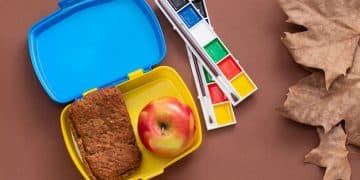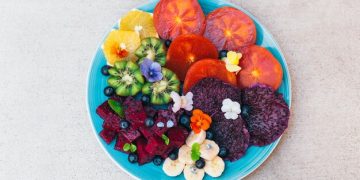Lunchbox Makeover: 10 Fun & Nutritious Ideas for Elementary Kids

Looking for fresh and exciting lunchbox ideas for your elementary school kids? This article provides 10 nutritious and fun options that will make lunchtime a hit, ensuring your child gets the energy and nutrients they need to thrive throughout the school day.
Is your child tired of the same old lunchbox routine? It’s time for a lunchbox makeover! Packing a nutritious and appealing lunch can be a challenge, but with a little creativity, you can create meals that your elementary schooler will love.
Lunchbox Basics: Nutrition for Elementary School Kids
Ensuring your child receives proper nutrition is crucial for their growth, development, and academic performance. A well-balanced lunch provides sustained energy and essential nutrients to keep them focused and active throughout the day. Understanding the basics of nutrition can help you create lunchboxes that are both healthy and appealing.
Key Nutrients for Growing Bodies
Elementary school is a critical time for growth, and children need a variety of nutrients to support this. Here are some key nutrients to focus on:
- Protein: Essential for building and repairing tissues, protein can be found in lean meats, beans, nuts, and dairy products.
- Fiber: Promotes healthy digestion and keeps children feeling full longer. Good sources include whole grains, fruits, and vegetables.
- Healthy Fats: Vital for brain development and hormone production. Include sources like avocado, nuts, and olive oil.
- Vitamins and Minerals: Crucial for overall health, these can be obtained from a variety of fruits and vegetables.
Prioritizing these nutrients in your child’s lunchbox ensures they receive the building blocks they need for optimal health and wellness. Variety is key to ensure they don’t become bored.
Portion Control and Balanced Meals
In addition to nutrient content, portion control is essential to prevent overeating and maintain a healthy weight. A balanced lunch should include:
- A source of protein to keep hunger at bay.
- Whole grains for sustained energy.
- Fruits and vegetables for vitamins, minerals, and fiber.
- A healthy fat source to support brain function.
By balancing these components, you create a meal that provides sustained energy and essential nutrients throughout the school day. This helps prevent energy crashes and promotes healthy eating habits. Using portioned containers can also help control the amount of food your child consumes, which is particularly helpful if your child tends to overeat.
In conclusion, understanding basic nutritional needs and practicing portion control are fundamental to building healthy lunchboxes for elementary school children. By incorporating key nutrients and balancing food groups, you can support your child’s growth, energy levels, and overall well-being.
10 Nutritious and Fun Lunchbox Ideas
Now that you know the basics of a healthy lunch, let’s explore 10 fun and nutritious lunchbox ideas that your elementary schooler will love. These ideas are designed to be easy to prepare, visually appealing, and packed with essential nutrients.

1. Mini Whole-Wheat Pizzas
Use whole-wheat English muffins as the base and let your child choose their favorite toppings, such as tomato sauce, cheese, and veggies.
- Why it works: Whole-wheat crust provides fiber, and the customizable toppings allow for a variety of nutrients.
- Preparation Tip: Prepare the muffins ahead of time, and let your child assemble them at school for a fun activity.
2. Hummus and Veggie Wraps
Spread hummus on a whole-wheat tortilla and fill it with colorful veggies like carrots, cucumbers, and bell peppers.
- Why it works: Hummus is a great source of protein and fiber, and the veggies add essential vitamins and minerals.
- Preparation Tip: Cut the wraps into bite-sized pieces for easy snacking.
3. Chicken Salad Sandwich on Whole-Grain Bread
Use lean chicken breast and mix it with Greek yogurt instead of mayonnaise for a healthier option.
- Why it works: Provides protein and a lower-fat alternative to traditional chicken salad. Whole-grain bread adds fiber.
- Preparation Tip: Add grapes or celery for extra flavor and nutrients.
4. Hard-Boiled Eggs and Fruit Salad
Hard-boiled eggs are a protein powerhouse, and a colorful fruit salad provides essential vitamins and antioxidants.
- Why it works: Easy to prepare and packed with nutrients, this is a simple and balanced lunch option.
- Preparation Tip: Include a variety of fruits like berries, melon, and kiwi.
5. Turkey and Cheese Roll-Ups
Spread cream cheese on sliced turkey and roll it up for a fun and protein-packed snack.
- Why it works: A good source of protein and calcium, these roll-ups are easy for kids to eat.
- Preparation Tip: Add a side of whole-grain crackers for extra fiber.
With these 5 ideas, you are well on your way to creating fun and healthy lunches for your children. But here are 5 more to add even more value to this.
6. DIY Taco Lunch
Pack seasoned ground turkey or shredded chicken, shredded cheese, lettuce, and whole-wheat tortillas separately. Let your child assemble their own tacos at lunchtime.
- Why it works: This interactive meal is fun, and it allows kids to customize their lunch with healthy options.
- Preparation Tip: Include small containers of salsa or guacamole for added flavor.
7. Pasta Salad with Veggies and Chickpeas
Use whole-wheat pasta and toss it with a light vinaigrette, chopped veggies, and chickpeas for added protein.
- Why it works: A filling and nutritious meal that provides complex carbohydrates, protein, and fiber.
- Preparation Tip: Add colorful veggies like bell peppers, cherry tomatoes, and broccoli for a visually appealing lunch.
8. Cottage Cheese with Fruit and Granola
Cottage cheese is a great source of protein, and adding fruit and granola provides a balance of essential nutrients and satisfying textures.
- Why it works: High in protein and calcium, this lunch option is both healthy and delicious.
- Preparation Tip: Use low-fat cottage cheese to reduce calorie intake and opt for a granola with low added sugar.
9. Quesadilla Cut into Shapes
Make a quesadilla with whole-wheat tortillas and cheese, and cut it into fun shapes using cookie cutters.
- Why it works: Cheese provides calcium and protein, while whole-wheat tortillas offer fiber.
- Preparation Tip: Consider adding black beans or cooked chicken for an extra boost of protein.
10. Yogurt Parfait with Berries and Nuts
Layer Greek yogurt with berries and a sprinkle of nuts for a protein-packed and antioxidant-rich lunch.
- Why it works: Greek yogurt is high in protein, and berries provide essential vitamins and antioxidants.
- Preparation Tip: Use plain Greek yogurt to avoid added sugars and let the sweetness of the berries shine through.
These 10 lunchbox ideas offer a variety of flavors and nutrients to keep your elementary schooler happy and healthy. Remember to involve your child in the preparation process to make lunchtime even more exciting.
Tips for Packing the Perfect Lunchbox
Packing a nutritious lunchbox that your child will actually eat requires more than just healthy ingredients. Here are some practical tips to ensure success, focusing on presentation, convenience, and involving your child in the process.
Presentation Matters
Kids are often more likely to eat what looks appealing. Here’s how to make lunchboxes visually attractive:
- Use colorful containers: Brightly colored lunchboxes and containers can make the meal more inviting.
- Cut sandwiches into fun shapes: Cookie cutters can transform ordinary sandwiches into exciting shapes like stars, hearts, or animals.
- Arrange food artfully: Organize the food in an appealing way, separating different items to prevent them from getting soggy.
Make it Convenient
Convenience is key for both you and your child. Here’s how to make lunchtime as easy as possible:
- Use reusable containers: These are environmentally friendly and make it easy to pack and unpack food.
- Pack snacks in individual portions: Pre-portion snacks like nuts, crackers, and fruit into small bags or containers to prevent overeating.
- Include utensils and napkins: Make sure your child has everything they need to eat their lunch comfortably.
Involve Your Child
Getting your child involved in the lunch-packing process can increase their enthusiasm and encourage them to try new things.
By incorporating these tips, you can ensure that your child’s lunchbox is not only nutritious but also appealing and convenient. Presentation, practicality, and involving your child are key elements in creating a lunchbox that supports their health and well-being.
Addressing Common Lunchbox Challenges
Despite your best efforts, you might face challenges when trying to implement healthy lunchbox habits. Here’s how to tackle some common issues such as picky eaters, time constraints, and keeping food safe.

Dealing with Picky Eaters
Picky eating is a common hurdle, but there are strategies to help expand your child’s palate:
- Introduce new foods gradually: Offer small portions of new foods alongside familiar favorites.
- Offer choices: Let your child choose between a few healthy options to give them a sense of control.
- Get them involved in the process: Let your child help with grocery shopping and meal preparation to increase their interest in trying new foods.
Overcoming Time Constraints
Busy schedules can make it difficult to pack healthy lunches. Here are some time-saving tips:
Finding a balance between addressing pickiness, managing time constraints, and ensuring food safety will set the stage for positive lunchtime experiences. With patience and persistence, you can create healthy lunchbox habits your child will embrace.
Creative Ways to Add Variety to Lunchboxes
Maintaining variety in lunchboxes can be a challenge, but creativity can help keep things interesting. Here are some creative ways to add variety and excitement to your child’s lunchtime routine.
Theme Days
Introduce theme days to add fun and anticipation to lunchboxes:
- Mexican Monday: Pack quesadillas, salsa, and a side of black beans.
- Italian Tuesday: Include mini pizzas, mozzarella cheese sticks, and cherry tomatoes.
- World Wednesday: Experiment with international flavors like sushi rolls, edamame, or hummus with pita bread.
Surprise Elements
Add small surprises to make lunchtime more enjoyable:
- Inspirational notes: Include a handwritten note with an encouraging message or a fun fact.
- Small treats: Occasionally include a small, healthy treat like a dark chocolate square or a homemade energy bite.
- Fun accessories: Use colorful toothpicks or food picks to add a playful touch to sandwiches and snacks.
Maintaining variety and adding creative elements can keep lunchboxes exciting and encourage your child to eat healthier. Theme days, bento boxes, and surprise elements can transform lunchtime into a fun and anticipated event.
| Key Point | Brief Description |
|---|---|
| 🍎 Balanced Nutrition | Ensure each lunch includes protein, whole grains, fruits, veggies, and healthy fats. |
| 🎨 Presentation Matters | Use colorful containers and cut foods into fun shapes to make lunchtime more appealing. |
| 🤝 Involve Your Child | Let your child participate in meal planning and packing to encourage healthier eating habits. |
| ⏰ Time-Saving Tips | Prepare components ahead of time and use leftovers to streamline lunch packing. |
Frequently Asked Questions
▼
Instead of sugary snacks, consider fresh fruits, vegetables with hummus, a small portion of nuts, or homemade energy bites. These options provide nutrients and sustained energy without the sugar crash.
▼
Use insulated lunchboxes and include ice packs or frozen water bottles to keep perishable items cold. Freeze yogurt tubes or juice boxes for an extra cooling effect and a refreshing treat.
▼
Excellent vegetarian protein sources include hummus, beans, lentils, tofu, edamame, and Greek yogurt. Combine these with whole grains and vegetables for a balanced and nutritious meal.
▼
To prevent soggy sandwiches, spread a thin layer of butter or cream cheese on the bread to create a barrier. Pack wet ingredients like tomatoes or cucumbers separately and assemble the sandwich at lunchtime.
▼
Instead of nuts, consider sunflower seeds, pumpkin seeds, or soy butter as alternatives. Always double-check product labels to ensure they are produced in a nut-free facility if your child has a severe allergy.
Conclusion
Transforming your child’s lunchbox into a source of nutrition and excitement is achievable with creativity and planning. By incorporating these ideas and tips, you can ensure your elementary schooler enjoys delicious, healthy meals that support their growth and learning.





